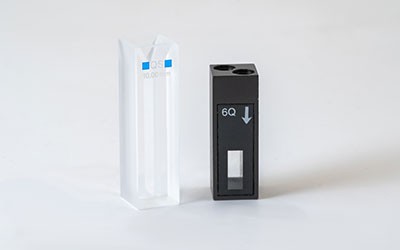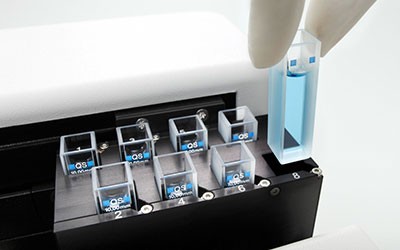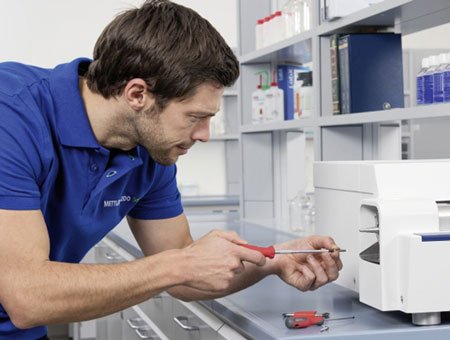We support and service your measurement equipment through its entire life-cycle, from installation to preventive maintenance and calibration to equipment repair.
Please choose your equipment type:

A cuvette for spectrophotometric measurements is a small, clear rectangular vessel available in different materials, quality levels, and dimensions. Glass cuvettes are used for measurements in the visible range from 320 to 2500 nm. Quartz cuvettes deliver precise results in the whole UV and visible range from 200 to 2500 nm. The smaller the manufacturing tolerance, the better and more repeatable the measurement.

Standard and Excellence cuvettes are available in 10 and 50 millimeter optical path lengths (OPL) and two glass versions: optical glass (O) for Vis and quartz glass (Q) for enhanced UV measurements. Special micro and flow cuvettes complete the portfolio to suit various application and automation needs.

Excellence cuvettes ensure outstanding window parallelism and offer small optical path-length tolerances of just ± 0.01 millimeters. This allows them to deliver the accuracy required for pharma and research applications.

Both Standard and Excellence cuvettes are designed for long-term use. This makes them an environmentally friendly choice that can also save you money by eliminating the ongoing purchase of disposable plastic cuvettes.

We support and service your measurement equipment through its entire life-cycle, from installation to preventive maintenance and calibration to equipment repair.
Please choose your equipment type:
The cuvette used to measure a sample is a part of the spectrophotometer’s optical system. Therefore, the position, geometry and condition of the cuvette can have an influence on the accuracy and precision of absorbance measurements and should be carefully controlled.
The optical path length of a cuvette is the distance of light that goes through the interior walls of a cuvette.
On a standard spectrometer cuvette, the light path or path length will be the inner distance from the front window to the back window. The standard cuvette optical path length is 10 mm.
The material of the cuvette can cause its own absorbance depending on the wavelength. Quartz cuvettes are completely translucent over the whole measuring range (UV/Vis). Disposable plastic cuvettes are quite often only translucent in the visible range of the spectrum. Therefore, the cuvette selection depends mainly on the application.
According to the Beer-Lambert law, absorbance is directly proportional to the cuvettes’ path length and sample concentration. Selecting an ideal path length (e.g. from 1 mm to 5 cm) can eliminate the need for dilutions. Absorbance that lies in the range of 0.2 A to 1.5 A generates the most accurate results. A microvolume instrument with a very short path length, (1 mm or 0.1 mm) is ideal for highly concentrated samples.
For best measurement practice, the cuvette should remain in the cuvette holder between the measurements. If removed, care should be taken to always position the cuvette in the same direction in the cuvette holder, i.e. with the label towards the light source. This ensures that the optical effects are identical for both reference and sample measurements.
For best results, the reference and sample measurements must be done using the same type of cuvette.
Cuvettes must have windows fabricated from a material that is transparent in the spectral region of interest.
For best results of measurements in the UV range, UV-transparent glass needs to be used, such as quartz glass or SUPRASIL® glass.
SUPRASIL® is a trademark of Heraeus (Quartz Glass)
For the visible range (>400 nm), optical glass or disposable PMMA (Polymethylmethacrylate) or PS (Polystyrene) cuvettes are frequently used.
Disposable cuvettes, made of poly-methyl-methacrylate, absorb in the UV range and act like a cut-off filter, making measurements in the UV range inaccurate and should only be considered for measurements within the visible range.
Mix the sample well before use, especially when re-suspending nucleic acids or proteins. Avoid using glass pipettes to fill the cuvette, as they could scratch the optical surface. Pipettes with disposable plastic tips are ideal. Let the solution run at the glass wall into the cuvette to avoid bubble formation. Do not exceed filling over 80% of its capacity.
The windows of the cuvette, through which the light passes, have to be cleaned before every use. For thorough inner and outer cleaning use a 60% isopropanol/deionized water solution and wipe with an optical cleaning cloth or lint-free tissue (to avoid scratches from lint on the surface).
To avoided higher absorbances cuvettes should be thoroughly cleaning before and after use. Additional care needs to be taken to avoid touching the windows after cleaning is complete. The sample should be removed immediately after the measurement to avoid any damage to the cuvette by evaporating solvents.
Higher absorbances are measured if residuals, such as fingerprints or grease, are deposited on the cuvette windows due to there being additional absorbing components. This can be avoided with thorough cleaning before and after use. Additional care must be taken to avoid touching the windows after cleaning is complete.
Hold cuvettes only on the frosted sides and be careful not to leave fingerprints on the cuvette.
Position the cuvette with the transparent side in the light beam, ensuring that the blank and sample cuvette label is pointing in the same direction. Make sure the cuvette is not tilted and is completely fixed in the cuvette holder. The cuvette must not move anymore.
In order to limit solvent evaporation or water absorption from ambient air in case of hydrophilic samples use the lid normally provided with the cuvette.
The flow cells must always be completely emptied after a series of measurements. To avoid calcification on the optical window, the inside of the flow cell should be rinsed with acetone and afterwards extensively dried in order to remove any residual acetone.
For short term storage, special cuvette holders are available. For long term storage, the delivered box should be used to avoid scratches and dust on the glass surface.
For best measurement practice, the cuvette should remain in the cuvette holder between the measurements. If removed, care should be taken to always position the cuvette in the same direction in the cuvette holder, i.e. with the label towards the light source. This ensures that the optical effects are identical for both reference and sample measurements. Thanks to the outstanding manufacturing tolerances of the METTLER TOLEDO Excellence cuvettes this preferred orientation is not necessary as the absorbance differences by 180 degrees are marginal.
If residuals, such as fingerprints or grease, are deposited on the cuvette windows, higher absorbance is measured due to there being additional absorbing components. This can be avoided with thorough cleaning before and after use. Additional care must be taken to avoid touching the windows after cleaning is complete.
A cuvette is a small rectangular tube to hold aqueous samples. It has straight sides made of clear, transparent material. Some also call them cells or capillaries. Cuvettes are used in spectrophotometric measurements to measure the absorbance of a specific wavelength.
If a cuvette shows scratches or smaller cracks in the polished field, it should not be used for further measurements as the result becomes adulterated or the cuvette could break inside the spectrophotometer. Any resin material used to repair or glue the cuvette would compromise the measurement quality. Therefore, repair of a broken cuvette is not recommended.
A blank cuvette is used to calibrate the spectrophotometer readings before measuring an unknown solution. The reading of the spectrograph is relative to the blank cuvette. There are environmental factors that may affect the reading, such as dust, temperature, and humidity. To eliminate all the external factors, the spectrograph readings of the blank cuvette are removed from the readings of the sample solution cuvette
METTLER TOLEDO Optical Glass: 320 – 2500 nm wavelength; >80% transmission rate; reusable; Visible Spectrum
METTLER TOLEDO Quartz Glass: 200 – 2500 nm wavelength; >82% transmission rate; reusable; UV-Visible Spectrum
The most common capacity is 3.5 ml (3500 µL) of a standard 10 mm macro cuvette. The volume of a cuvette can easily be calculated: inner length x inner width x inner height x 80% = cuvette volume
A matched pair of cuvettes describes two cuvettes of the same material that have the same optical path length. Due to designated manufacturing tolerances, matched pairs ensure comparable measurements. METTLER TOLEDO Excellence cuvettes assure manufacturing tolerances of just ± 0.01 mm and therefore need no matching.